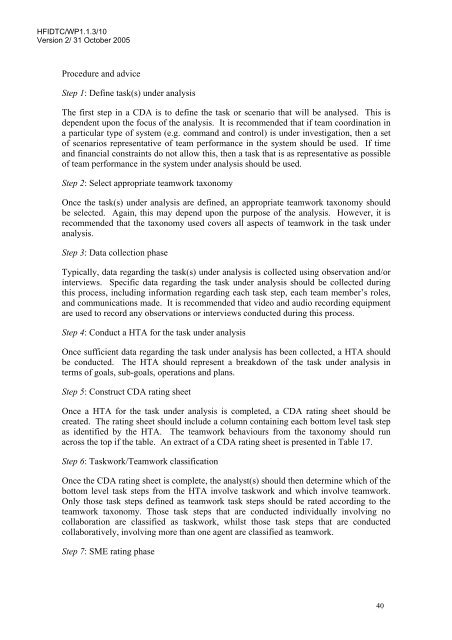A Review of the Event Analysis of Systemic Teamwork Methodology
A Review of the Event Analysis of Systemic Teamwork Methodology
A Review of the Event Analysis of Systemic Teamwork Methodology
- No tags were found...
Create successful ePaper yourself
Turn your PDF publications into a flip-book with our unique Google optimized e-Paper software.
HFIDTC/WP1.1.3/10<br />
Version 2/ 31 October 2005<br />
Procedure and advice<br />
Step 1: Define task(s) under analysis<br />
The first step in a CDA is to define <strong>the</strong> task or scenario that will be analysed. This is<br />
dependent upon <strong>the</strong> focus <strong>of</strong> <strong>the</strong> analysis. It is recommended that if team coordination in<br />
a particular type <strong>of</strong> system (e.g. command and control) is under investigation, <strong>the</strong>n a set<br />
<strong>of</strong> scenarios representative <strong>of</strong> team performance in <strong>the</strong> system should be used. If time<br />
and financial constraints do not allow this, <strong>the</strong>n a task that is as representative as possible<br />
<strong>of</strong> team performance in <strong>the</strong> system under analysis should be used.<br />
Step 2: Select appropriate teamwork taxonomy<br />
Once <strong>the</strong> task(s) under analysis are defined, an appropriate teamwork taxonomy should<br />
be selected. Again, this may depend upon <strong>the</strong> purpose <strong>of</strong> <strong>the</strong> analysis. However, it is<br />
recommended that <strong>the</strong> taxonomy used covers all aspects <strong>of</strong> teamwork in <strong>the</strong> task under<br />
analysis.<br />
Step 3: Data collection phase<br />
Typically, data regarding <strong>the</strong> task(s) under analysis is collected using observation and/or<br />
interviews. Specific data regarding <strong>the</strong> task under analysis should be collected during<br />
this process, including information regarding each task step, each team member’s roles,<br />
and communications made. It is recommended that video and audio recording equipment<br />
are used to record any observations or interviews conducted during this process.<br />
Step 4: Conduct a HTA for <strong>the</strong> task under analysis<br />
Once sufficient data regarding <strong>the</strong> task under analysis has been collected, a HTA should<br />
be conducted. The HTA should represent a breakdown <strong>of</strong> <strong>the</strong> task under analysis in<br />
terms <strong>of</strong> goals, sub-goals, operations and plans.<br />
Step 5: Construct CDA rating sheet<br />
Once a HTA for <strong>the</strong> task under analysis is completed, a CDA rating sheet should be<br />
created. The rating sheet should include a column containing each bottom level task step<br />
as identified by <strong>the</strong> HTA. The teamwork behaviours from <strong>the</strong> taxonomy should run<br />
across <strong>the</strong> top if <strong>the</strong> table. An extract <strong>of</strong> a CDA rating sheet is presented in Table 17.<br />
Step 6: Taskwork/<strong>Teamwork</strong> classification<br />
Once <strong>the</strong> CDA rating sheet is complete, <strong>the</strong> analyst(s) should <strong>the</strong>n determine which <strong>of</strong> <strong>the</strong><br />
bottom level task steps from <strong>the</strong> HTA involve taskwork and which involve teamwork.<br />
Only those task steps defined as teamwork task steps should be rated according to <strong>the</strong><br />
teamwork taxonomy. Those task steps that are conducted individually involving no<br />
collaboration are classified as taskwork, whilst those task steps that are conducted<br />
collaboratively, involving more than one agent are classified as teamwork.<br />
Step 7: SME rating phase<br />
40
















